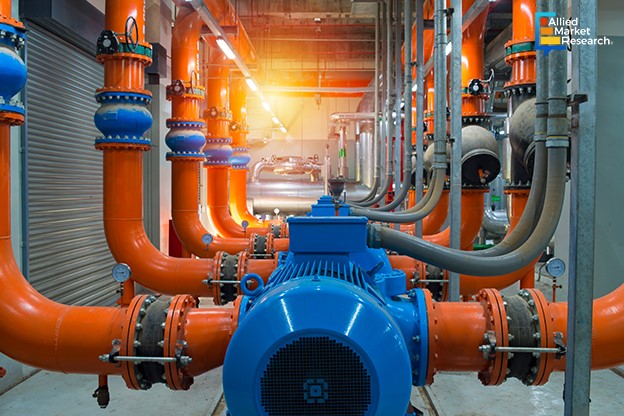How Automation and IoT Have Revolutionized the HVAC Pump Sector?

22 Apr
2025
Highlights:
- Introduction
- Role of advanced technologies in industry growth
- Product launches in the market
A HVAC pump is the most important component of heating, ventilation, air conditioning, and refrigeration systems. The machines facilitate the circulation of refrigerants, water, and other such fluids to maintain and regulate the temperature within the system. Over the years, different types of HVAC pumps, such as single-stage pumps, multi-stage pumps, centrifugal pumps, in-line pumps, end-suction pumps, and booster pumps, have been developed to suit their diverse needs and applications in various end-use industries. Based on their flow rate, pressure, size, capacity, and energy efficiency, these pumps are used in different residential, commercial, and industrial applications.
Advancements in HVAC technologies are creating new investment opportunities
In the last few years, new types of HVAC systems have emerged with the advent of new technologies and innovations. For instance, the integration of IoT and automation solutions has enabled companies to develop smart HVAC pumps that perform their functions based on external climate conditions and parameters like temperature, humidity, air pressure, etc. Several multinational consumer electronics manufacturers have started designing programmable thermostats and smart ACs. These units feature pumps that are triggered or activated automatically based on the inputs fed to them. In addition to this, the introduction of voice-assistant systems helps users monitor the performance and control the functioning of HVAC pumps remotely, thus increasing convenience and comfort significantly.
The use of AI and machine learning algorithms has led to the development of energy-efficient HVAC pumps, thus creating numerous investment opportunities in the industry. Compared to conventional HVAC systems, which have very high-power consumption, AI-powered solutions reduce energy bills through usage pattern analysis and resource optimization. These advanced tools can study and predict the problems that are likely to arise in the functioning of HVAC pumps, thus minimizing the cost and time required for repair and maintenance.
In recent years, the growing awareness regarding environmental sustainability has compelled companies to opt for renewable energy sources to power HVAC systems. Furthermore, the promotion of innovative solutions such as geothermal heat pumps has broadened the scope of the industry considerably. These machines extract warmth from the ground and use it to perform different functions, thus reducing the need for electricity.
Launch of innovative products by key industry players, bringing new investment opportunities
The HVAC pump industry was valued at $36.6 billion in 2024 and is anticipated to surge at a CAGR of 5.7% during 2025-2034, gathering a sum of $63.3 billion by 2034. The launch of innovative products by leading companies is predicted to bring lucrative opportunities for the industry. For instance, in June 2023, Kirloskar Brothers Limited (KBL), a multinational pump manufacturing company, unveiled a vertical inline long coupled pump for heating, ventilation, and air conditioning systems. Rama Kirloskar, joint managing director at KBL, stated in the press release that the pump is designed to be installed in airports, railway stations, hotels, hospitals, and other such commercial establishments. With a discharge capacity of up to 550 m³/hr, the product has been designed to minimize energy consumption and operate smoothly even in harsh weather conditions.
Similarly, in March 2024, Trane Technologies, a manufacturing company, announced the expansion of its product portfolio with the launch of a new line of HVAC pumps and systems, designed specifically for the residential sector. The press release issued by the company highlighted that the products feature an advanced refrigerant that has 78% less global warming potential (GWP) than traditional solutions, thus making them highly sustainable machines. Recently, Trane Technologies has initiated a program called the Gigaton Challenge, through which the company voluntarily declared that it would be reducing one billion metric tons of GHG emissions from its operations by 2030. The launch of this new series of heat pumps is expected to aid the company in achieving its target, thus helping decarbonize the HVAC industry in the long run.
To sum it up, the growth of the HVAC pump market is attributed to the rising applicability of heating, ventilation, and air conditioning systems in various end-use industries. Moreover, recent advancements in HVAC pumps, such as the integration of AI and IoT, are anticipated to help the sector flourish. In addition, the shift toward renewable power sources like geothermal energy is predicted to open new avenues for growth in the landscape.
Contact our experts for tips and recommendations on how to capitalize on the opportunities offered by the industry!

Akhilesh Prabhugaonkar
Author's Bio- Akhilesh Prabhugaonkar holds a bachelor’s degree in Electronics Engineering from the reputed Vishwakarma Institute of Technology. He has a special interest in the fields of forensics, world history, international relations and foreign policy, sports, agriculture, astronomy, security, and oceanography. An ardent bibliophile and melophile, Akhilesh loves to write on topics of his interest and various other societal issues. This love for writing made him enter the professional world of content writing and pursue his career in this direction.
Avenue: Entire Library membership of Allied Market Research Reports at your disposal
- Avenue is an innovative subscription-based online report database.
- Avail an online access to the entire library of syndicated reports on more than 2,000 niche industries and company profiles on more than 12,000 firms across 11 domains.
- A cost-effective model tailored for entrepreneurs, investors, and students & researchers at universities.
- Request customizations, suggest new reports, and avail analyst support as per your requirements.
- Get an access to the library of reports at any time from any device and anywhere.
Related Post
-
How are Submarine Cables Transforming Global Connectivity with Enhanced User Experience?
-
Endoscopy Procedures: Transformations in Techniques and Applications
-
AI-Powered Video Analytics: How the Product Actually Works for enterprises
-
Painting Robots: Transforming Precision Coating and Creative Applications
-
Innovations in Pharmacovigilance Systems Advancing Patient Safety
-
Understanding Edge Security: Keeping Data Safe Near the Source
-
Exploring the Use and Advancements of 3D Laser Scanners in Professional Applications
-
Reinforcing Industrial Controls with Smarter Tools and Training








